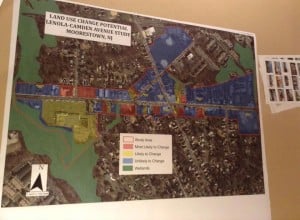
More than 50 Lenola residents, business owners and concerned citizens came to the Lenola Fireman’s Memorial Hall last Wednesday night to put on their thinking caps and become planners and developers to give feedback on how they would like to see the Lenola section of Moorestown in the future.
Moorestown’s Lenola Ad Hoc Committee, along with the Burlington County Bridge Commission’s Office of Economic Development and Regional Planning, hosted a visioning workshop at the Lenola Fireman’s Memorial Hall on Wednesday, Oct. 14.
The point of the workshop was to get feedback from the public on what they were concerned with and what they would like within the Lenola section of Moorestown.
“Tonight, we’re going to ask residents and visitors to be planners and developers. Planning is three ingredients: What do you have? What do you want? And how do you get what you want? Our job tonight is to tell you a little bit about what we found, or what you have; give you an exercise, what do you want; and come back next time and talk about how do we get there,” Regional Planning Coordinator Ed Fox said.
The workshop started with a brief history of Lenola and what has progressed and what needs to be worked on. The latter was divided into three sections: circulation (or traffic), land use (or zoning and redevelopment) and streetscaping (or the look and feel of streets).
Circulation
Progress was made when Camden Avenue was restriped in 2013 to provide safer on-street parking; council adopted a Complete Streets Policy for 2015 for all times of vehicular, foot and bicycle traffic; the township worked with NJ Transit in 2015 to designate bus stops and bus shelters along Camden Avenue; and the township started working with the county in 2015.
Remaining issues were rush hour congestion with a high number of accidents; existing sidewalks that are narrow and not pedestrian friendly; and bicycle safety that needs to be improved on Lenola and New Albany roads.
“We looked at traffic — one of the major concerns that you call have, that we all have. Camden Avenue is a pretty busy street. It gets about 15,000 trips per day on the avenue. A lot of it is backed up on Lenola Road, which gets about 9.000 trips per day,” Fox said.
Land use
Progress was made when council adopted “Town Center” type use and bulking zone standards and parking requirements in 2008 and designated areas between the 7-Eleven and Moorestown Oaks a “redevelopment area” in 2010.
Remaining issues include many zoning and land use limitations, not up-to-date or legal policies, and no plan that has been adopted for the redevelopment area to incentivize change.
Streetscaping
Progress was made when council adopted “Town Center” type landscaping and signage design guidelines in 2009 and the Camden Avenue pocket park was constructed in 2014 and maintained by McDonalds.
Remaining issues include zoning, which controls architectural designs of buildings; streetscape design guidelines that are needed; the pocket park having only two benches with a few trees, no lighting or other amenities; revisiting other neighborhood parks for enhancement; and a lack of street trees.
After the presentation, those who attended were asked to fill out surveys on what they would like to see.
“Imagine what you want (the Lenola Business District) to be, your ideal situation,” Fox said.
The first survey addressed the public realm, which included crosswalks, bicycle travel, sidewalks, Camden Avenue pocket park, street trees, street lighting, bus travel, automobile parking, vehicular travel, street furniture, corridor gateways and signage. The survey asked about things such as adding additional structures, the look and feel of the streets, and speed limit changes.
The second survey was on land use, which included Jeff Young Park and community center; redevelopment; architectural standards; bulk standards; and other land uses. The survey asked about the maintenance and adequacy of the park, tax questions and areas for redevelopment; the regulation of architectural standards; the proximity and height of buildings for bulk standards; and the types of buildings wanted in the study area.
The final survey on land use change potential asked residents what they would like to see at certain properties for redevelopment if they were ideal and ready to develop.
After the surveys were filled out and collected, the public was given time to talk about their concerns, ask questions and give suggestions.
The public all felt traffic was a big issue and gave suggestions on how they thought things could be addressed.
They also mentioned parking as a problem, suggesting some redevelopment areas used for parking lots, as well as the unsafe conditions of the sidewalks.
Fox said the next steps are to go through the surveys, process the information collected and come back for further investigations or with future suggestions.
All of this would take about a month, according to Fox.
“We’ll be back and try to give you information in a month’s time,” Fox said.
To get more information, ask questions or provide suggestions, email Fox at [email protected].









